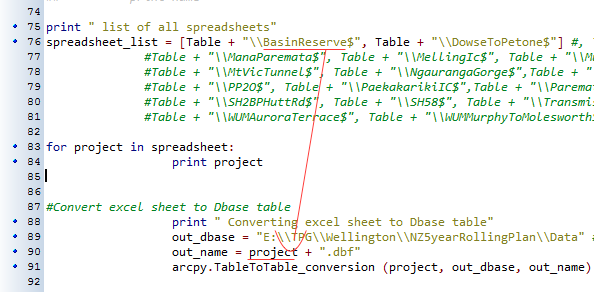- Home
- :
- All Communities
- :
- Developers
- :
- Python
- :
- Python Questions
- :
- i have got a list of excel spread sheets that i wa...
- Subscribe to RSS Feed
- Mark Topic as New
- Mark Topic as Read
- Float this Topic for Current User
- Bookmark
- Subscribe
- Mute
- Printer Friendly Page
i have got a list of excel spread sheets that i want to convert in to .dbf and save them with the same name. can someone tell me how to could you use the sheet name only from the whole path in spreadsheet list, thanks
Accepted Solutions
- Mark as New
- Bookmark
- Subscribe
- Mute
- Subscribe to RSS Feed
- Permalink
Something like this will work, and I can see the dbf in Catalog, but couldn't open in Excel. It may be do to the name and/or column lengths I had in my sample. you would need to play with that. But it depends on what you are are planning on using the .dbf files for.
import arcpy import os theWorkspace = r"c:\__temp" arcpy.env.workspace = theWorkspace sheets = ["BasinReserve", "DowseToPetone", "ManaParemta"] table = "anExcel.xlsx" table = os.path.join(theWorkspace, table) print table for sheet in sheets: inputTable = table + "\\" + sheet + "$" print inputTable arcpy.TableToTable_conversion(inputTable, theWorkspace, sheet )
- Mark as New
- Bookmark
- Subscribe
- Mute
- Subscribe to RSS Feed
- Permalink
If you just need to convert the filename from xls to dbf, this is how I did something similar in a recent project.
It recursively searches a directory for any files with the extension you want (in this case ".xls"), then generates a filename in an output directory with the other extension (".pdf").
import os.path rootdir = r'C:\projects' outpath = r'C:\output' for (dirName, subdirList, fileList) in os.walk(rootdir): for filename in fileList: if os.path.splitext(filename)[1].lower() == ".xls": pdffilename = os.path.join(outpath, filename[:-3] + "pdf") // do your conversion here print pdffilename
- Mark as New
- Bookmark
- Subscribe
- Mute
- Subscribe to RSS Feed
- Permalink
Can you please: 1.) post your code directly (help here) so we can help without typing out your example, and 2.) provide exactly what 'print project' produces? It appears you have two different lists: "spreadsheet" and "spreadsheet_list". As it is written, we need to know what's in "spreadsheet".
- Mark as New
- Bookmark
- Subscribe
- Mute
- Subscribe to RSS Feed
- Permalink
Hi Darren this is what i am trying to do, add all the information from spreadsheets to a feature class by joining tables copying information and removing join
- Mark as New
- Bookmark
- Subscribe
- Mute
- Subscribe to RSS Feed
- Permalink
The point of my post was that I don't particularly care what your script does, I just wanted to help without having to type out the relevant parts of your script. By posting your code directly into a code block, we can copy/paste it into our response - we can't do that with a screenshot.
In any case, it looks like Rebecca has gone to the trouble of typing out a functioning solution, so I'd go with that.
- Mark as New
- Bookmark
- Subscribe
- Mute
- Subscribe to RSS Feed
- Permalink
What Darren mean is, check out Posting Code blocks in the new GeoNet instead of just a screen shot. Can't help as much without the code.
- Mark as New
- Bookmark
- Subscribe
- Mute
- Subscribe to RSS Feed
- Permalink
Something like this will work, and I can see the dbf in Catalog, but couldn't open in Excel. It may be do to the name and/or column lengths I had in my sample. you would need to play with that. But it depends on what you are are planning on using the .dbf files for.
import arcpy import os theWorkspace = r"c:\__temp" arcpy.env.workspace = theWorkspace sheets = ["BasinReserve", "DowseToPetone", "ManaParemta"] table = "anExcel.xlsx" table = os.path.join(theWorkspace, table) print table for sheet in sheets: inputTable = table + "\\" + sheet + "$" print inputTable arcpy.TableToTable_conversion(inputTable, theWorkspace, sheet )
- Mark as New
- Bookmark
- Subscribe
- Mute
- Subscribe to RSS Feed
- Permalink
Thanks Rebecca, this piece of code took me a while to get it but was helpful. Cheers
- Mark as New
- Bookmark
- Subscribe
- Mute
- Subscribe to RSS Feed
- Permalink
So were you able to get it to do what you needed? I haven't really dug into your code, but it sounds like you are joining a bunch of tables so you can copy attributes to one of them from the other? Have you looked at
Join Field—Help | ArcGIS for Desktop ?? That allows you to join (permanently) to tables based on a in_field matching join_field, and you can select which of the fields you want from the join_table.
Sample from help:
# Purpose: Join two fields from a table to a feature class # Import system modules import arcpy from arcpy import env # Set the current workspace env.workspace = "c:/data/data.gdb" # Set the local parameters inFeatures = "zion_park" joinField = "zonecode" joinTable = "zion_zoning" fieldList = ["land_use", "land_cover"] # Join two feature classes by the zonecode field and only carry # over the land use and land cover fields arcpy.JoinField_management (inFeatures, joinField, joinTable, joinField, fieldList)
That might be what you are trying to do?
- Mark as New
- Bookmark
- Subscribe
- Mute
- Subscribe to RSS Feed
- Permalink
Yeah i got that working. Join field dint really seem helpful because of the long processing time and the number of fields i have to deal with.
